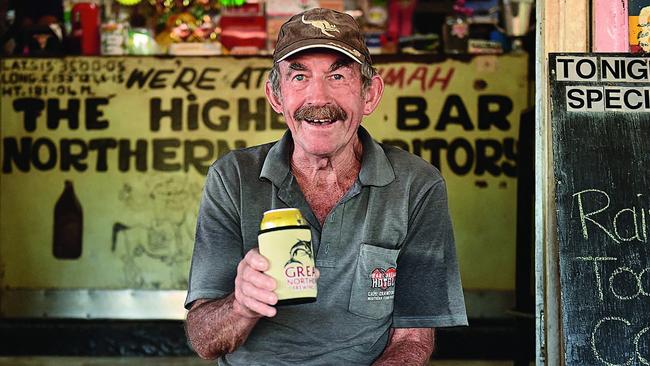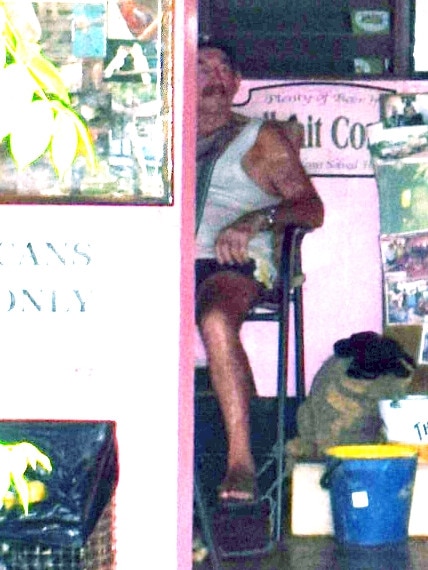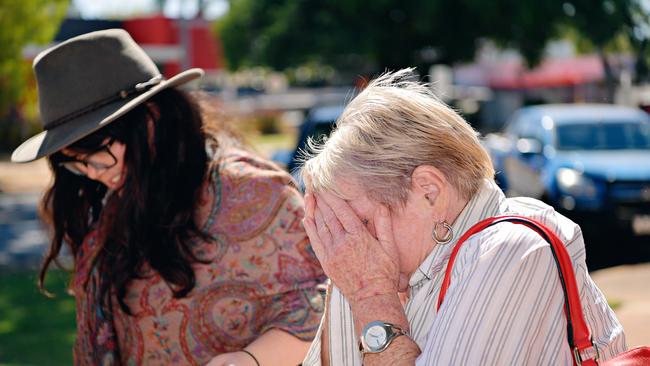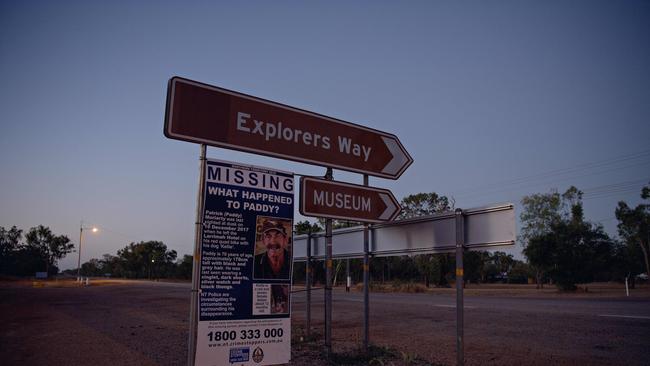Lost in Larrimah: mystery lingers in an outback town
Three years after their hit podcast, two writers have unearthed more in the case of missing NT man Paddy Moriarty, including mystery children he likely fathered in an outback ‘native camp.’

Around dusk on Saturday, December 16, 2017, Paddy Moriarty upped and left the bar at the Larrimah Hotel. As authors Caroline Graham and Kylie Stevenson put it, “Paddy had been in fine form … He’d upgraded his daily eight mid-strength beers to 10, and had left with a bit of a wobbly boot on. He was drunk, but not drunk-drunk. He wasn’t Paddy-drunk.”
Paddy rode off on his quad bike with his red kelpie, Kellie, and neither was ever seen again. Paddy was 70 years old and yes, he had the odd enemy among the other 11 residents of the outback town 500 kilometres from Darwin on the Stuart Highway.
Paddy Moriarty’s disappearance was the subject of the authors’ Walkley Award-winning 2018 podcast, Lost in Larrimah. Three years on, the NT police are still hunting for Paddy and his dog, and Graham and Stevenson have developed their podcast into a book.
“We had a lot of issues that we didn’t have time to explore in the podcast,” Stevenson tells Review from her home in Darwin.
LOST IN LARRIMAH: Listen to the entire podcast series here
“You could probably say we’d over-researched. We felt there were bigger issues to explore, not just a disappearing man, but the disappearing town of Larrimah and even the disappearing way of life in the outback.”

Stevenson is the only one of the pair to have actually met Paddy, while she was attending a writers’ residency at Larrimah in 2016. “He was just an old guy living in a small town in the outback,” she recalls. “I used to wander into the bar and see him and Rover [the dog Paddy owned before Kellie]. We’d sit and have a chat.”
It was after Stevenson left Larrimah that Paddy vanished, leaving behind his keys, bank card, glasses and “good hat”. By then she knew about his feuds, especially with Fran, the proprietor of the town’s teahouse, whose pies Paddy would warn tourists not to eat.
When he was not badmouthing Fran and her pies, Paddy would entertain tourists with his “well-worn tales” about “the shootout he was involved in at the Heartbreak Hotel or all the shenanigans he got up to as a young man working as a ringer on Brunette Downs”. There was more to those “shenanigans” than Paddy let on.
“When I met Paddy he told me he had children somewhere out in the outback,” Stevenson says. “Not knowing I’d be spending the next five years of my life writing about Larrimah, I didn’t really push for answers.”

What she and Graham discovered was that Paddy probably had a “handful of kids” with an Aboriginal woman from the so-called “native camp” at Brunette Downs, one of Australia’s biggest cattle stations. The woman’s identity, and what became of the children, were mysteries, but scouring historical records convinced the authors that such relationships could not possibly have been conducted on equal terms but were “generally accepted as a by-product of isolation and gender imbalance on the stations”. Some stations were said to have encouraged the practice as a way of holding onto their white labour force. Others simply turned a blind eye.
“The more we read the worse we feel,” Graham and Stevenson write. “His not-knowing how many children he had suddenly makes sense. Any relationship between a white man and an Aboriginal woman (or vice versa) was so taboo it would have likely been kept quiet and if there were children, the father might not have been involved in their upbringing.”

The Paddy we read about in the book is a more complicated figure than the Paddy we met in the podcast. The authors write about “uncovering things about him we wish we didn’t know”.
“We wrestled with this,” Graham says. “When you start looking deeply into something it tends to become more complex. You could say that was true of the town, too. We came to see Larrimah as a microcosm of every aspect of humanity. We saw it in Paddy himself – he had every aspect of humanity within him. And we felt there was some value in pulling that issue – relations between white stockmen and Aboriginal women – to the surface of Australian history.”
When they began working on Lost in Larrimah, Graham and Stevenson had been friends for more than a decade, having met on Mackay’s Daily Mercury. “Caro had been listening to me talk about the place for over a year,” Stevenson says. “She got it, and I knew she was a brilliant writer. Plus I had a newborn so there was no way I could do it alone. He came with us to Larrimah and was often strapped to my chest while we interviewed people.” Over the years, she jokes, she and Graham have “kind of merged into the one person. We call ourselves Kyro.”
A former journalist on the “croc-obsessed” NT News, Stevenson knew that Paddy was far from alone in having vanished under macabre circumstances in the vastness of the Northern Territory. Before Paddy there was Peter Falconio and hundreds of others whose names have never made national, let alone international, headlines.
Driving along a “rough, secluded road”, the authors find themselves thinking “we might not make it anywhere before dark if we stay too long at Brunette, so we start scoping out roadside stops, just in case we get caught up. They’re all bleak, isolated, and out of reach of phone reception. Mostly, they just look like good places to get murdered.”
Chances are that is what happened to Paddy Moriarty. Graham and Stevenson spoke to police investigating the case and weighed up other possibilities: Paddy might have been bitten by a snake, collapsed from dehydration or a heart attack, or even fallen down a sinkhole. But two things militated against all these theories: his “good hat” and his dog. An experienced bushman like Paddy would never have left home without his hat; and if some accident had befallen Paddy, someone would have found his dog. The most plausible explanation was that whoever had killed Paddy also killed his dog.
By the end of the book, Graham and Stevenson admit they are no closer to knowing what happened to Paddy Moriarty.
“We’re three years deep,” they write, “and less sure than when we started.” A postscript notes that in February 2021 the NT police offered a reward of $250,000 for information about Paddy’s disappearance.

But the book was always going to be about more than Paddy. “We found some answers,” Graham says, “but every answer turned up half a dozen more questions.”
Asked what she feels they have accomplished, she says, “We’ve created a record for people who knew and loved Paddy. There has been a sustained investigation into what happened; he didn’t just disappear and get forgotten. People in Australia and internationally have taken a keen interest in wanting justice for him.”
Beyond that, Graham hopes the book will stand as a record of the town Paddy loved and of the way of life that exists there.
“If two strangers knocked on your door in the city, you might not have anything to tell them,” she says, “but every person here had the most extraordinary stories. We became obsessed with the idea that people are shaped not just by history but also by the places where they live, and it’s almost impossible to live an ordinary life in these extraordinary places. I hope we’ve written an honest but also a warm tribute to that way of life.”
Larrimah by Caroline Graham and Kylie Stevenson is published by Allen and Unwin (392pp, $32.99). Listen to The Australian’s Lost in Larrimah podcast on your favourite podcast app.

To join the conversation, please log in. Don't have an account? Register
Join the conversation, you are commenting as Logout